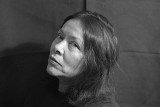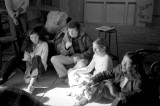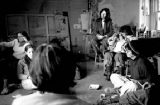Preface to lecture at Rutgers University, Nov. 8, 2006
When the Waters Break:
The Dialectics of Representation
I grew up on a tidal inlet. I think I always thought those days that all rivers were salt and had jellyfish and horseshoe crabs. I spent every summer day on that beach swimming with the other kids or just drying off in the sun, almost sleeping or deraming, soaking up the smells, the sounds, the salt drying on the skin, the heat of the sun drking me up – until I couldn’t stand it any more – and into the water I went.
Cross my river one could see a spit of land, a peninsula called Germantown. It looked so green and inviting I longed to go there. For all those sunny days of childhood I looked at it and longed to have it, to see it up close, to be there. One day when I was in my teens I decided to go for it – to swim across my river, to actually touch the magical island. I went with my little black dog, Julie, who of course, paddled rings around me until we finally got there… and found – when I climbed up on the beach – I was impossible to walk into gorgeous green flourishing landscape because I was made of the coarsest toughest spikes of marsh grass I had ever seen. Every spike was a sword! I swam back sadder but wiser. It seemed like a step into adulthood.
Many years later when I lived in upstate New York, I found a lovely still quiet river with huge trees growing out of the far side, looking back at them, I stand in the river inching slowly forward, absorbing every color, every tone, every change, before I will dive in, dive under the water, becoming totally part of all I see. But – suddenly – standing there, looking down at my foreshortened legs distorted by the water, I see tiny fish, minnows, all around me, coming for the dusty rust-colored ribbons – like smoke – coming out of – where the water laps against the crotch of my bathing suit. I am menstruating and the minnows are feeding off my blood. I feel like river god – a goddess!! I am part of everything I see.
“When the Waters Break” refers to two things: The way the world outside of us, of “ourselves” makes its own decisions, goes its own way – ripens in its own time (Katrina, for instance), and, secondly, the way the world within us also ripens in its own time, recognizes what it needs, what it wants, when it is read t do so. The way we can be very confused, at a loss, and then suddenly we know, we recognize what we have been waiting for, looking for. There it is. It’s there, here.
So, with a work of art, you put into it all the things you think will bring about the desired result. You push, you pull, you change, you backtrack, you start over, you are distraught, you think your in the wrong field, you take a walk, you take a drink, you try something you’ve never done before, you turn the piece you’re working on upside down, you consider cutting into little bits and re-constituting it – and one morning you get out of bed and you quietly sneak into the studio and – it has completed itself. And you realize this has been a dialogue between you and the living organism tht is a work of art. It is beyond you, outside of you. you are its handmaiden, its doola.
And the desired result may look nothing like you though it would.
May Stevens.
The Irish Cliffs of Moher
Who is my father in the word, in this house,
at he sprits base?
My father’s father, his father’s father, his –
shadows like the winds
Go back to a parent before thought, before speech,
at the head of the past.
They go to the cliffs of Moher rising out of the mist,
above the real,
Rising out of the present time and place, above
the wet,, green grass.
This is not landscape, full of the somnambulating
of poetry
And the sea. This is my father or, maybe,
it is as he was,
A likeness, one of the race of fathers: earth
and sea and air.
Wallace Stevens
Publicity for Jan. 2006 talk in Santa Fe
May Stevens was born in Boston, Massachusetts in 1924 but grew up in Quincy, a city ten miles south of Boston, on a tidal inlet. Two things about Quincy influenced her strongly: the presence of the river she spent her childhood swimming in and her awareness of the historical significance of Quincy with its crypts in the stone temple in Quincy square which housed the bodies of presidents John and John Quincy Adams, second and fourth presidents of our country. The river with its jelly fish and horseshoe crabs gave her a sense of freedom and a connection with the nature she has never lost; the knowledge of two of our first presidents having lived in te town she lived in gave her a deep appreciation of your lineage, where we come from, what it means to be born, into this country with its origins in a dream of freedom and equality, or to choose to come to live here for those reasons.
These two sources show up in the life-work Stevens has and continues to establish. The many works on water look to her abiding understanding that we are part of the natural world and that we must honor and protect it. During the civil rights movement under Dr. Martin Luther King she depicted the “freedom riders” who went south in the buses to join the fight for integration. During the war in Vietnam she created a series of “Bid Daddy” paintings satirizing the complacency of those who said “my country right or wrong.” During the feminist movement of the 1970’s and 80’s she chose to compare and connect two women who where émigrés, her mother who came from Canada to the united states looking for work and a better life with Rosa Luxemburg who went from Poland to Germany looking for opportunity for the work she wanted to do, working for better lives for the poor who were underfed, undereducated and had little or no control over their own lives and the lives and futures of their own families.
At the same time Stevens is in love with art, with beauty, with feeling. Her work strives to touch deep emotions and offer an experience that speaks to our common need.
Her Water Paintings, some of the 10 to 14 feet in length, and her smaller works on paper and numerous lithographs (some of them done at tamarind in Albuquerque) and mixed media works frequently bear handwriting, small, almost illegible, usually written in flickering gold or sliver, and creating an atmosphere of light and movement of air, currents of water, or, maybe jus the pressure of thought and feeling that activates the artist’s hand and, hopefully the viewer’s response.
For more information about the artist’s work and where to see it or to learn more about her history of exhibitions, reviews, books which talk about her work, check Mary Ryan gallery in N.Y.C’s Chelsea area and see the recent publication on her life and work “May Stevens” by Patricia Hills, published by pomegranate in 2005, in Petaluma, CA. The monograph is available at Garcia st. books in Santa Fe.



